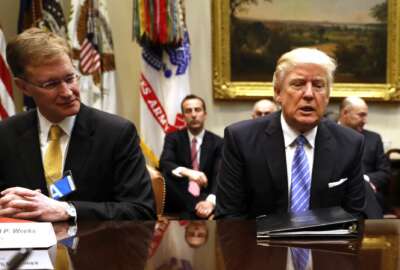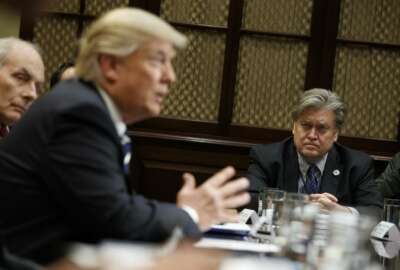
Pentagon orders 16 specific exemptions to federal hiring freeze
Deputy Defense Secretary Robert Work, the deputy Defense listed 16 separate functions that will be immune from the hiring freeze.
The Defense Department on Thursday announced a sweeping set of exceptions to the governmentwide civilian hiring freeze President Donald Trump imposed on Jan. 23, allowing hiring to resume across broad categories of the workforce ranging from cybersecurity specialists to depot maintenance and shipyard personnel.
Invoking a provision of Trump’s executive order that allows agencies to exempt positions they deem critical to national security and public safety, Robert Work, the deputy Defense secretary, listed 16 separate functions that will be immune from the freeze. But in a memo to the military departments, combatant commanders and agency heads who will carry out the guidance, he also cautioned that they must be prepared to defend their decisions to exempt any individual position.
“I will follow closely any actions taken with respect to implementation of the hiring freeze and will hold these officials accountable for the exemptions they grant,” Work wrote.
A senior Defense official, speaking to reporters on the condition of anonymity, acknowledged that some of the categories were drafted very broadly. For instance: “Positions necessary to carry out or enforce treaties or other international obligations.” But DoD expects its officials to use the authorities as sparingly as possible.
“Designated officials will really have to look at the functions of the position, the duties and make sure that they are absolutely necessary to meet our national security or public safety responsibilities,” the official said. “True, we accept risk every day, but the officials will have to provide alternatives and look for ways to meet the department’s needs without filling the position.”
In addition to the specific mission areas Work identified in the memo, which also include childcare workers, firefighters and police, nuclear operations, intelligence, civilian mariners, medical and mortuary staff and several others — DoD organizations will be allowed to grant additional exceptions if they can make the case that they have critical national security hiring needs that aren’t addressed in the exemption guidance. If they choose to use that authority, they’ll have to submit reports justifying each position they fill.
Trump’s executive order and DoD’s new guidance also expressly forbid managers from using additional contractor personnel to circumvent the intention of the hiring freeze, which is meant to gradually reduce the size of the workforce through attrition. But because of their decentralized nature, service contracts are notoriously difficult to monitor from a headquarters level; DoD has struggled over the years even to count the total number of contractors in its employ.
“The designated officials will really need to be cognizant of that,” the Defense official said. “It will be their responsibility to monitor that.”
Beyond the specific exceptions identified in Work’s memo, such as those for depot maintenance personnel, the guidance does not make any broad allowances for employees whose salaries are paid through self-sustaining accounts like non-appropriated funds or working capital funds, even though those positions are not directly connected to DoD’s appropriated spending. In general, the freeze applies to all hiring, regardless of a position’s funding source.
Also notably absent from the list of exceptions was DoD’s acquisition workforce, which has been the subject of a gradual but concerted rebuilding effort following major cutbacks during the 1990s. Nineteen members of Congress wrote to the president on Wednesday asking for an exemption for contracting and acquisition personnel, apparently to no avail.
“In an effort to secure a fair and reasonable price, these federal civilian professionals are gradually contributing to the force restoration our military so desperately needs,” the lawmakers wrote. “Each Service currently confronts a readiness … our military needs its acquisition personnel fully staffed and fulfilling their public service. Yet the military departments are now interpreting the hiring freeze memorandum to include these federal civilians essential to national security and military readiness.”
Defense officials were not able to quantify the total number of positions that would be affected by the exemptions, nor provide an estimate of how quickly the workforce would shrink with the freeze (and the exceptions) in place. But in general, 7-to-8 percent of DoD’s workforce departs each year through separations and retirements. The Air Force has estimated that the freeze will leave about 13,000 of its civilian positions vacant within about four months, but that figure was calculated before DoD announced its exemption policy.
More Defense News
Over the long term, the Pentagon hopes to use the hiring freeze and the process it’s now undertaking to prioritize positions for their national security importance in order to make broader workforce shaping decisions, including to comply with Trump’s order for the government to come up with a comprehensive strategy for reducing the size of the federal workforce, beyond merely freezing hiring.
“This is really an opportunity for the department to assess its most critical missions and requirements, ensuring that members of our civilian workforce are assigned and capable of executing our highest-priority work,” the official said. “The department’s guidance will help us accomplish this objective and ensure that resources are allocated in a manner that will promote effective and efficient use of taxpayer dollars. While remaining consistent with the president’s objectives, the department will ensure that applicants for DoD positions are treated fairly and consistently as the policy is implemented.”
A full list of the specific exemptions Work identified in his memo is below:
- Positions directly supporting the execution of contingency missions and operations, scheduled military operations and deployments, and security cooperation exercises or training
- Positions required for cybersecurity and cyberspace operations or planning
- Positions required for space operations or planning
- Positions required for execution of the cyber and intelligence lifecycle operations, planning, or support thereof
- To the extent necessary to maintain capability to ensure a medically ready force, positions directly providing inpatient care in Department of Defense Medical Treatment Facilities and providing acute and emergency outpatient care in Department of Defense medical and dental facilities. Additionally, positions involving communicable disease prevention and similar public activities.
- First responder firefighter and law enforcement positions
- Positions necessary to carry out or enforce treaties and other international obligations
- Positions providing operational support to the President of the United States, Secretary of Defense, or Chairman, Joint Chiefs of Staff
- Positions providing child care to the children of military personnel
- Positions at the installation level providing direct support to the prevention of child abuse, sexual assault, domestic violence, and suicide and providing direct support to those affected
- Positions required for nuclear reactor and nuclear weapon safety and security and nuclear command, control, and communications. Additionally, positions required for biological select agent safety and security
- Positions performing mortuary affairs activities and other directly related services necessary to properly care for the fallen and their families
- Positions required to be filled by a foreign national employee
- Positions in shipyards and depots in which positions incumbents perform direct management of inventory and direct maintenance of equipment
- Positions funded by Foreign Military Sales
- Civilian Mariners in Military Sealift Command
Copyright © 2025 Federal News Network. All rights reserved. This website is not intended for users located within the European Economic Area.
Jared Serbu is deputy editor of Federal News Network and reports on the Defense Department’s contracting, legislative, workforce and IT issues.
Follow @jserbuWFED
Related Stories





